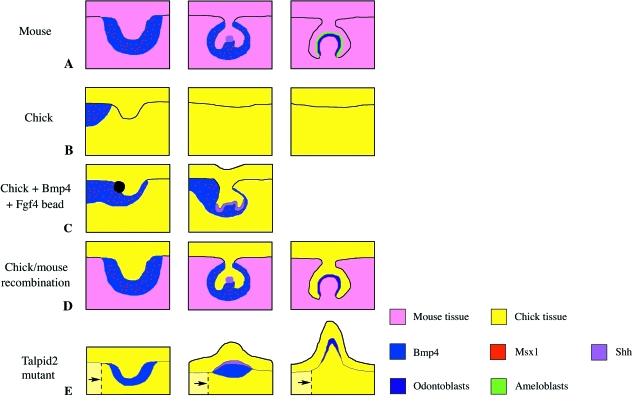Fig. 3.
A shift in the positioning of the odontogenic epithelium relative to the dental competent mesenchyme could explain the loss of the ability to form teeth in the modern bird ancestor. Schematic drawings summarizing the chick tooth experiments. (A) Mouse molar developmental stages, from bud [embryonic day (E)12.5] to cap (E14.5) to bell (E16.5). The condensing mesenchyme around the bud stage tooth germ expresses Bmp4 and Msx1 and induces development of the enamel knot at the cap stage, which expresses signalling molecules such as Shh. The inner enamel epithelium forms the ameloblasts that form enamel, whereas the adjacent mesenchyme forms the odontoblasts that form dentine (see Caton & Tucker, 2009). (B) Chick development. At Hamburger & Hamilton (HH) stage 28 a bud-like thickening of the oral epithelium is observed. Expression of Bmp4 and Msx1 is not, however, associated with this region. No further tooth development is observed at later stages and the thickening regresses. Note that, at an earlier stage (stage 24), Bmp4 expression is epithelial and shifts into the mesenchyme at stage 28 (Francis-West et al. 1994). (C) When a bead impregnated with Bmp4 and Fgf4 is implanted into the chick epithelium, the expression of Bmp4 and Msx1 in the mesenchyme extends around the developing tooth bud. This leads to the extension and folding of the bud epithelium, and induction of Shh. No further progression of the tooth germs is observed, however (Chen et al. 2000). (D) When mouse mesenchyme is combined with chick epithelium (either by recombination of mandible tissue or by earlier neural crest grafts of mouse neural crest into a chick embryo), the chick epithelium induces Msx1 and Bmp4 in the mouse mesenchyme. The tooth germ progresses to the cap stage and forms an enamel knot-like structure expressing Shh. The mouse tissue differentiates into odontoblasts and forms a bell stage tooth germ. Tooth differentiation does not proceed beyond this stage and enamel is not deposited (Wang et al. 1998; Mitsiadis et al. 2003). (E) In the chick mutant talpid2 a shift in the positioning of the epithelium and mesenchyme has been described (indicated by dashed lines and arrows). The chick epithelium is able to induce expression of Bmp4 in the underlying mesenchyme and expresses Shh. The tooth germ develops by evagination, similar to that observed in alligator embryos. At later stages differentiated odontoblasts are identified by histology but no further differentiation occurs (Harris et al. 2006).

